Following the ROG Zephyrus G16, the ROG Zephyrus G14 came to our testing laboratory – as you might guess, it is equipped with a 14-inch display. The G14 is smaller and lighter than the G16, but is still well suited for modern games with high system requirements. And this fact in itself is an excellent motivation to study the new ASUS product in as much detail as possible.
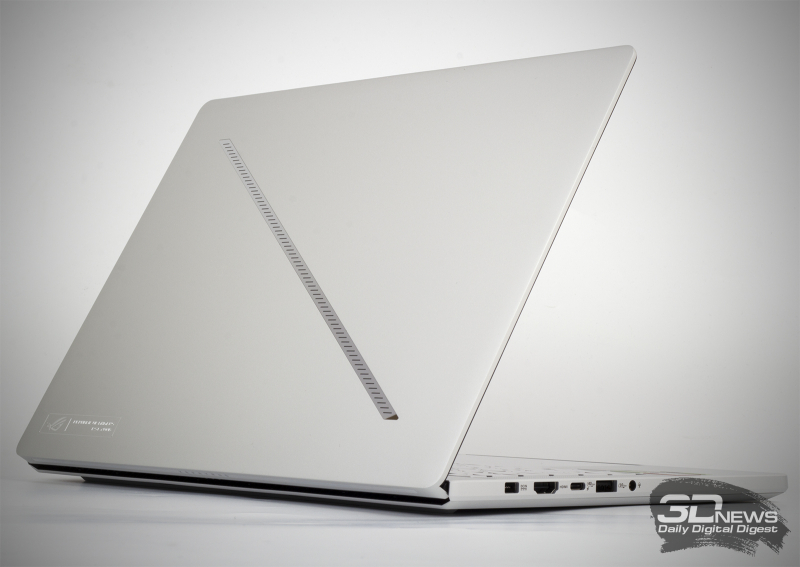
ASUS ROG Zephyrus G14 (2024)
⇡#Technical characteristics, equipment and software
ASUS has taught us that each new version of ROG Zephyrus – be it the G16 or G14 series – has a large number of modifications. On sale you will find models not only with the mobile version of the GeForce RTX 4070, but also with the GeForce RTX 4060 and even the GeForce RTX 4050. But the platform is used the same – with an 8-core Ryzen 9 8945HS processor of the Zen 4 generation. What’s nice is that All Zephyruses have 32 GB of memory – you can’t expand the RAM in a laptop, but this amount is more than enough for games. Other characteristics of ROG Zephyrus G14 (2024) GA403 are indicated in the table and screenshots.
GeForce RTX 4060, 8 GB GDDR6
GeForce RTX 4050, 6 GB GDDR6
Wi-Fi: Mediatek Wi-Fi 6E MT7922 (802.11b/g/n/ac/ax)
1 × USB 3.2 Gen2 Type-C (data, DisplayPort)
1 × USB 4 (data, DisplayPort, Power Delivery)
1 × HDMI 2.1
1 × 3.5mm mini jack
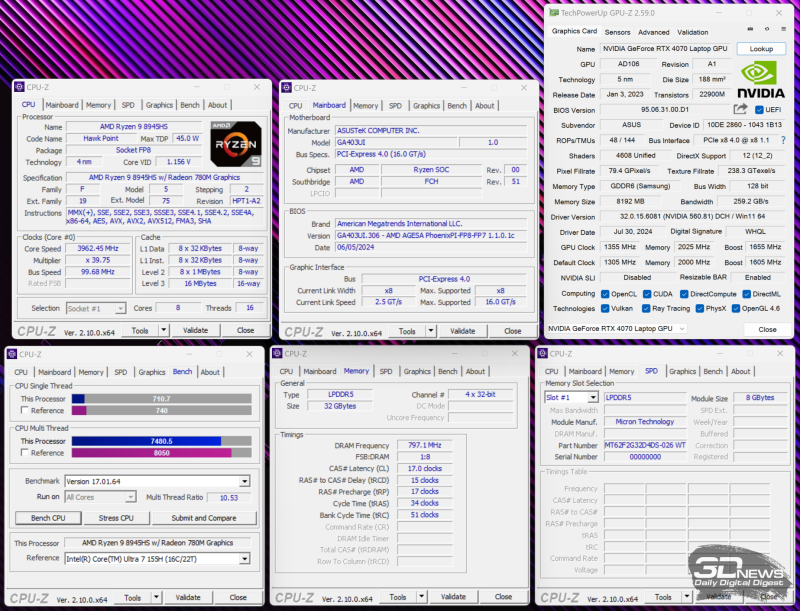
⇡#Appearance and input devices
Everything that we wrote about the ROG Zephyrus G16, discussing its appearance, functionality and design features, can also be applied to the ROG Zephyrus G14. The device is assembled in a metal case, the aluminum parts of which are processed on ultra-precise CNC machines. Finishing is preceded by 12 stages, including grinding, polishing and anodizing. Indeed, the laptop is built with high quality. A white model arrived to us, but there are “Zephyruses” on sale, assembled in a gray case. The metal is non-staining and very pleasant to the touch. The keyboard does not flex, and the display lid can be easily opened with one hand.
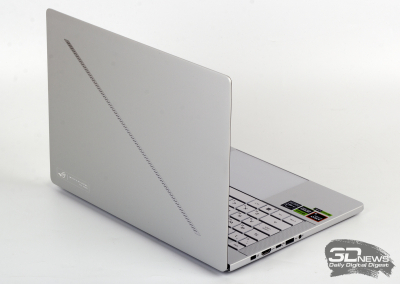
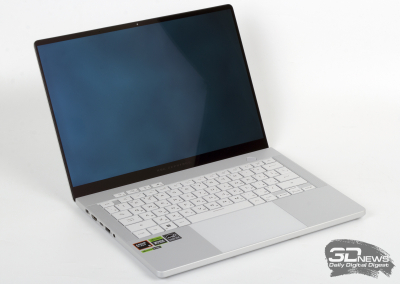
As always, Zephyrus series laptops look strict and at the same time very stylish. The hero of the review is often compared to the MacBook Pro 14 – I think, mainly in a complimentary way. And yet the style and handwriting of the Taiwanese manufacturer is visible to the naked eye: here you have the corporate logo of the ROG series in the corner, and the inscription “ZEPHYRUS” (this series of laptops has already become a cult), and the original Slash Lighting (it supports 15 animation templates, including an audio wave and notification mode).
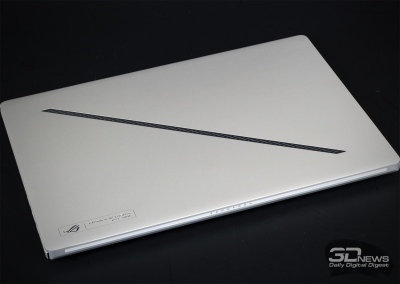
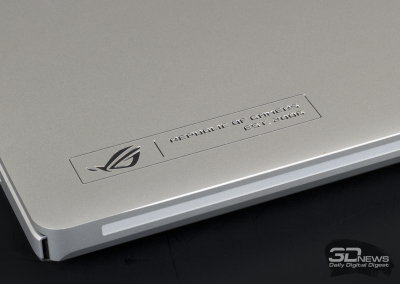
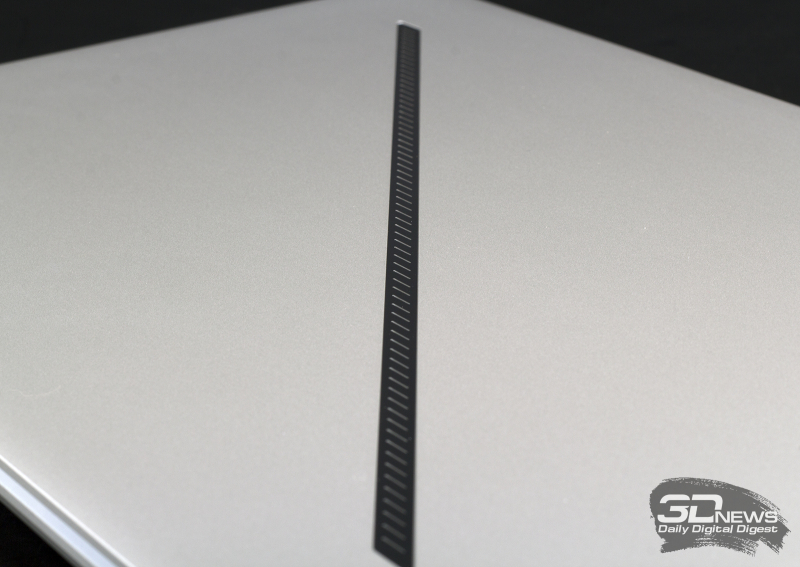

In July, I praised the ROG Zephyrus G16 for its modest size and light weight for this form factor. It’s all the more impressive because it contained a mobile GeForce RTX 4090. In turn, the ROG Zephyrus G14 turned out (quite expectedly, however) even smaller and lighter – the device weighs only 1.5 kg. The thickness of the case excluding the legs is 16 mm. And at the same time, the manufacturer managed to find a place for the GeForce RTX 4070 in this little one. For example, the Razer Blade 14 (2024) also has this chip installed, but the laptop itself turned out to be both thicker and heavier.
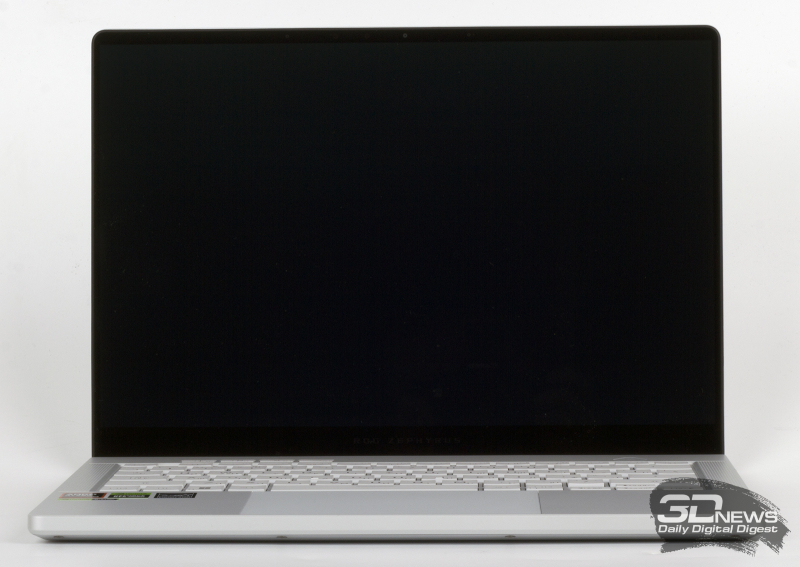
The laptop lid opens up to about 135 degrees. The design uses fairly tight hinges – and there are four of them at once. The display of the mobile PC has thin frames – on the top and sides their thickness is 8 and 4 mm, respectively. Thanks to the 16:10 screen aspect ratio and glossy finish, the display appears to take up 100% of the laptop’s lid area. On top there is a Full HD webcam, sensors and microphones.


Heated air is blown out only from the back – and under the display cover so that the latter does not heat up. The computer interfaces located on the sides of the case are as far away from the user as possible. On the right is a Micro-SD (UHS-II) card reader and USB 3.2 Gen2 A- and C-type. The last connector is combined with the DisplayPort output. On the left side of the case there is a proprietary power connector, an HDMI 2.1 video output, a 3.5 mm jack for connecting a headset, USB 4 combined with DisplayPort 2.1 and Power Delivery 3.0, and USB 3.2 Gen2 A-type.
The ROG Zephyrus G14 kit includes two power supplies. The power of the main energy source is 180 W, and the additional one is 100 W. The second power supply is connected to a Type C USB port. With it, the laptop operates at lower power – the “Turbo” and “Efficient” modes will be blocked.
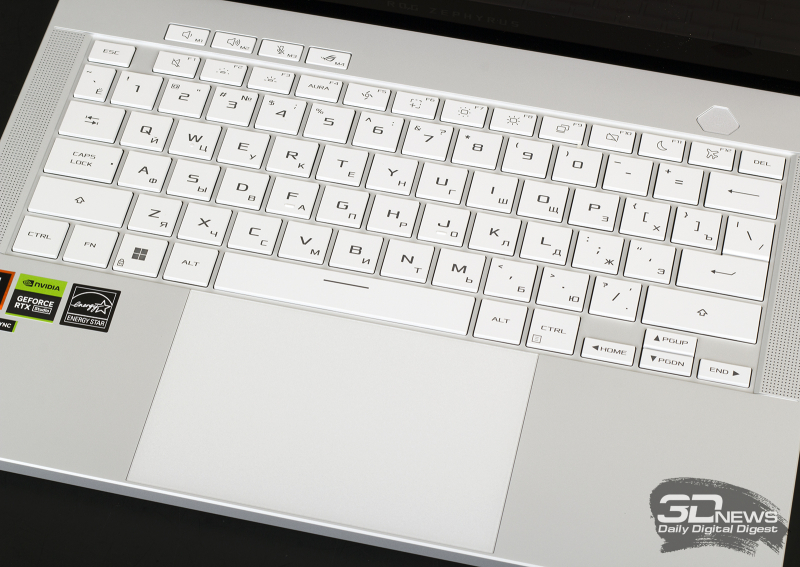
The ROG Zephyrus G16 and ROG Zephyrus G14 share the same keyboard. The manufacturer claims that the button caps have been increased by 12.2%, and their travel depth is 1.7 mm. The durability of the keyboard has also increased, by almost a quarter – now the key lifespan is 20 million keystrokes. The ROG Zephyrus G14 keyboard features single-zone RGB lighting.
For obvious reasons, it was not possible to install a large touchpad in the version of the laptop with a 14-inch screen. The aspect ratio of the touch panel in the ROG Zephyrus G14 is 127 × 79 mm and tends to be 16:10. ASUS is confident that using the laptop this way is easier and more comfortable.
In general, the reviewer’s keyboard and touchpad are comfortable – I didn’t find any problems in work or games.
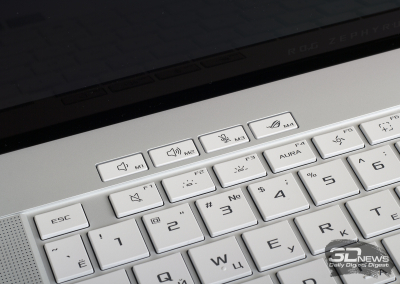
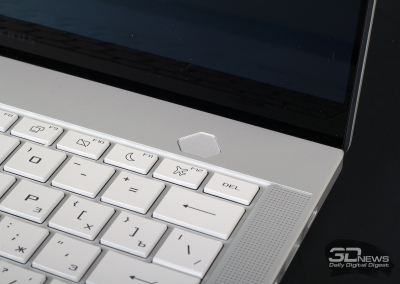
⇡#Internal design and upgrade options
The bottom cover of the laptop can be easily removed, but removal requires a torx screwdriver. Everything else is a matter of technique, proceed carefully.
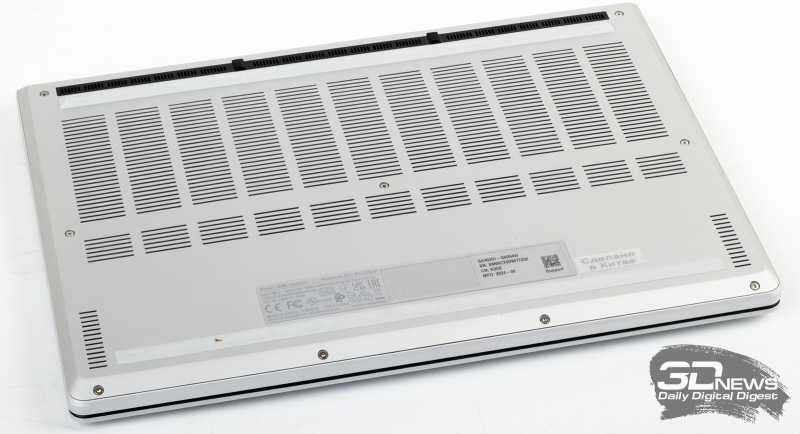
The older ROG Zephyrus G16 models are known to use a vapor chamber, but not here. At the same time, the cooling system of the ROG Zephyrus G14 is interesting. The cooler has three fans, three copper heat pipes and two copper radiators. Two heat pipes are common for the CPU and GPU. Liquid metal from Thermal Grizzly is used as an interface; its thermal conductivity is 14 times higher than that of conventional thermal pastes. Another tube removes heat from the chip power subsystem. ASUS claims that the copper in the laptop works 26% more efficiently – due to the mesh wick located inside the tubes.
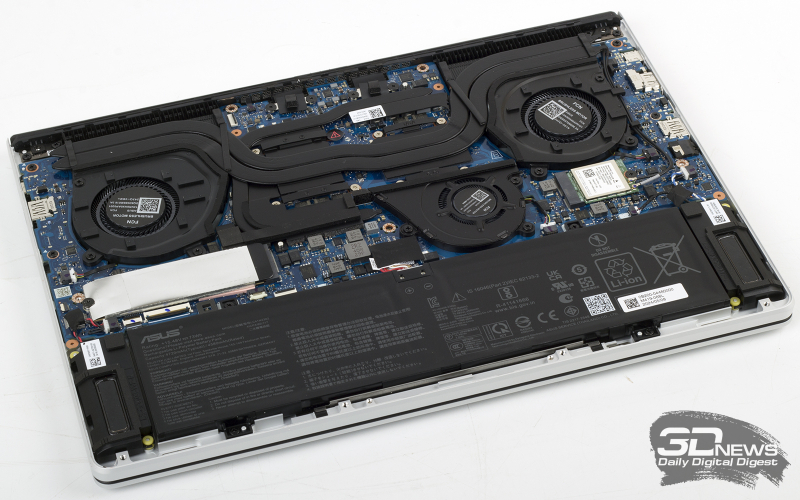
The main Arc Flow 2.0 fans received two rows of blades – 126 pieces in total. The thickness of each blade is 0.1 mm. The result is an 11% increase in airflow and a 16% reduction in impeller energy consumption. The third “Carlson” removes heated air that accumulates above the central and graphics chips.
Each fan is equipped with a dust filter.
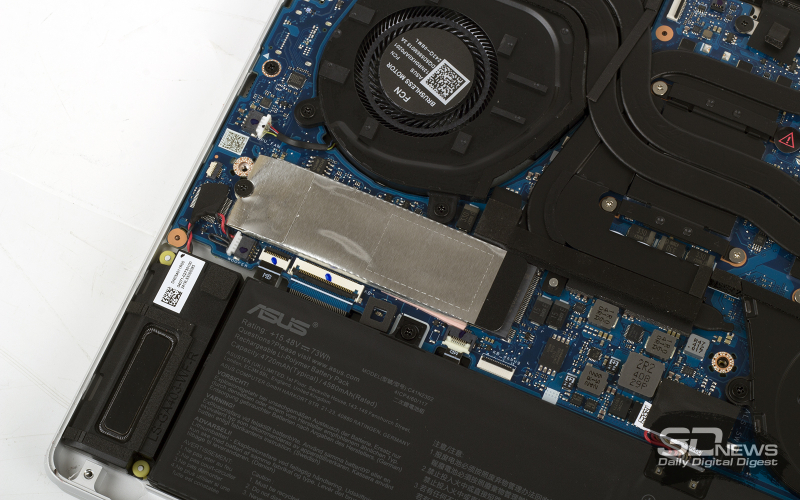
The memory on the laptop is soldered – all versions of the ROG Zephyrus G14 are equipped with LPDDR5X-6400 chips with a total capacity of 32 GB. There are only two components in the system that you can replace yourself: the SSD drive and the wireless module.
⇡#Display
It just so happens that all ASUS laptops that have been in my tenacious paws over the past six months are equipped exclusively with OLED matrices. Both the Zenbook 14 OLED (UX3405), the Zenbook Duo UX8406MA, and the ROG Zephyrus G16 (2024) have excellent displays that are perfect for both work and play. And ROG Zephyrus was no exception. We see that a cool OLED screen is a signature feature of elite ASUS gaming computers.
⇡#Testing methodology
When measuring the performance of gaming laptops, we traditionally focus on computer games. Testing is carried out in Full HD and WQHD resolution (if supported) for laptops with 16:9 displays and WUXGA and WQXGA for laptops with 16:10 displays. Frame rate measurements were carried out in the following games:
- The Witcher 3: Wild Hunt – Complete Edition. DirectX 12. Novigrad and surroundings. Graphics quality “Extraordinary+”, RT – off, TAAU, NVIDIA HairWorks – off, dynamic resolution – off.
- Watch Dogs: Legion. DirectX 12. Built-in benchmark. Maximum graphics quality, TAA, RT – off, DLSS – off, additional detail – 0%.
- Cyberpunk 2077. DirectX 12. Built-in benchmark. Graphics quality mode – “Impressive”, textures – “High”, RT – off, DLSS/FSR – off.
- A Plague Tale: Requiem. DirectX 12. Mission “Under a Different Sun”. Graphics settings – “Ultra”, resolution scale – 100%, DLSS – off, shadow tracing – off.
- RoboCop: Rogue City. DirectX 12. Walk around Detroit. Maximum graphics quality, upscaling – off.
- Red Dead Redemption 2. Vulkan. Built-in benchmark (last scene). Maximum quality (advanced settings – off), TAA.
- Alan Wake 2. DirectX 12. Forest. Quality Template – High, Post Processing Quality – High, Volumetric Lighting – High, Highlight Quality – High, Shadow Resolution – High, SSAO, Trace – Off, Transparency – off
- Baldur’s Gate III. DirectX 11. Walk through Baldur’s Gate. Overall graphics quality – “Ultra”, DLSS/FSR – off, 16x AF, TAA.
- Grand Theft Auto V. DirectX 11. Built-in benchmark (last scene). Maximum quality, FXAA + 4x MSAA, additional quality settings – on, 16x AF, image resolution scale – off.
- Black Myth: Wukong Benchmark Tool. DirectX 12. Built-in benchmark. Maximum graphics quality, TSR, frame generation – off, full ray tracing – off, anti-aliasing oversampling – 100%.
For a visual comparison of different laptop models, we introduced a performance index, in which the test results of the reference system – a desktop, which includes a Core i7-14700KF central processor, 32 GB of DDR5-6000 RAM (32-38-38-46) are taken as 100%. ) and a GeForce RTX 4070 12 GB video card. Points are calculated as a percentage of the performance of the reference gaming system, multiplied by 10. The test bench used the Windows 11 operating system with all updates installed (summer 2024), as well as NVIDIA graphics driver version 555.99.
Most gaming laptops are equipped with matrices with a high frame rate. To check the feasibility of using such displays, we tested the laptop in the following popular online projects:
- Counter-Strike 2 (min. quality). DirectX 11. Dust II card. The current quality setting template is “Low”, FSR is off.
- Counter-Strike 2 (max. quality). DirectX 11. Dust II card. The current quality preset is “Very High”, FSR is off.
- Dota 2 (min. quality). DirectX 11. Match recording. Minimum graphics quality, screen processing quality – 100%, FSR – off.
- Dota 2 (max quality). DirectX 11. Match recording. Maximum graphics quality, screen processing quality – 100%, FSR – off.
- PUBG: BATTLEGROUNDS (min. quality). DirectX 11. Training mode. Overall graphics quality is “Very Low”, display scale is 100%.
- PUBG: BATTLEGROUNDS (max. quality). DirectX 11. Training mode. The overall graphics quality is “Ultra”, the display scale is 100%.
Gaming performance was determined using the well-known CapFrameX program. It allows you to get the rendering time of each frame. The use of the 1st percentile instead of the minimum number of frames per second indicators is due to the desire to clear the results from random performance fluctuations that were caused by reasons not directly related to the operation of the main components of the platform.
The following resource-intensive applications were used:
- Blender 4.1.0. Determining the final rendering speed in one of the popular free 3D graphics packages. The speed of building standard scenes (monster, junkshop, classroom) used to measure performance is measured.
- Cinebench R23 and Cinebench 2024. Measuring the performance of photorealistic 3D rendering in the CINEMA 4D animation package, CPU test.
- Corona 10 Benchmark. Testing rendering speed using the renderer of the same name. The speed of building a standard scene used to measure performance is measured.
And also comprehensive benchmarks:
- 3DMark Professional Edition. Testing in the Steel Nomad and Speed Way scenes.
- Futuremark PCMARK10 Professional Edition 2.1.2574 64. Testing in scenarios Essentials (the usual work of the average user: launching applications, surfing the Internet, video conferencing), Productivity (office work with a word processor and spreadsheets), Digital Content Creation (creating digital content: editing photographs, non-linear video editing, rendering and visualization of 3D models).
And browser tests (Firefox Portable 117.0.1):
- JetStream 2.2. Testing web scripts based on JavaScript and WebAssemblies covering a variety of complex workloads and programming techniques.
- WebXPRT 4: Test web scripts based on HTML5, JavaScript, and WebAssembly, covering a variety of complex workloads and programming techniques.
Testing of the laptop in games, resource-intensive applications and complex benchmarks was carried out with the activation of the fastest mode suitable for these tasks.
Display testing is performed using the X-Rite i1Display Pro colorimeter and DisplayCAL 3 application.
The battery life of the laptop was tested in two modes. The first load option – web surfing – involves alternately opening and closing tabs on the sites 3DNews.ru, Computeruniverse.ru and Unsplash.com with an interval of 30 seconds. For this test, the Google Chrome browser version current at the time of testing is used. In the second mode, video in .mkv format and Full HD resolution is played in the built-in Windows OS player with the repeat function activated. In all cases, the display brightness was set to the same 200 cd/m2, and the keyboard backlight (if any) and sound were turned off. The wireless communication module worked constantly.
⇡#Operating modes
The review hero offers several operating modes – they are switched by a keyboard shortcut and in the Armory Crate application. Three presets are available to the user: “Quiet”, “Efficiency” and “Turbo”. We tested the ROG Zephyrus G14 in all of them.

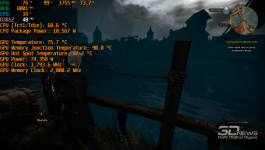
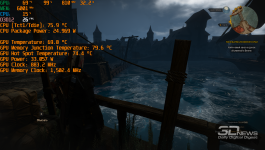
Test results
The main question when looking at the ROG Zephyrus G14 is: how is the GeForce RTX 4070 cooled in a laptop? We see that GPU power consumption is reduced – the maximum value in Dynamic Boost mode reaches 90 W. In The Witcher at a resolution of 2560 × 1600 pixels, when the graphics processor is loaded at 100%, the total power consumption of the CPU and GPU reaches an average of 100 W – apparently, this is the value that the laptop cooler is designed for. In all modes, the cooling system does its job well – for example, when the “Turbo” and “Efficiency” presets are enabled, the CPU and GPU temperatures do not exceed 80 degrees Celsius even at their peak. What is important is that the video memory of the GeForce RTX 4070 works with a slight factory overclock.
In the “Turbo” mode, the ROG Zephyrus G14 operates quite noisily, but at the same time it is quiet, if we compare the review hero with the recently tested Acer Predator Triton Neo 16 model under the same conditions. In the “Efficiency” mode, the laptop operates quietly, and in the “Efficiency” mode Quiet” – really quiet. Depending on the system requirements, you can switch between presets – in many applications, a comfortable frame rate will be achieved in the Quiet mode.

Heating of the laptop case (games, “Turbo” operating mode)
The smaller the laptop’s motherboard, the closer the CPU and GPU are located to each other. Such close proximity can lead to serious heating of the keyboard. The body of the ROG Zephyrus G14 does not get very hot where the user’s hands are located. The hottest point, of course, is the place where the heated air leaves the enclosure. Flows do not reach the surface of the OLED display. The temperature of the WASD block is even below the human 36.6 degrees Celsius.
Fast Matrix
Conventional wisdom has it that a gaming PC requires a display with a high vertical scan frequency and low response time. The question is debatable; it has been raised several times in our articles, including in comments to laptop reviews. The reality is that even inexpensive gaming laptops are equipped with matrices with a frequency of 120 Hz and higher. But does this make sense?
The fact is that achieving a frame rate that matches the scanning frequency of a laptop display turns out to be quite difficult. Even the most powerful AMD and NVIDIA laptop graphics will not provide decent FPS in applications with serious system requirements when using high quality graphics or higher. Including after enabling various methods of scaling and image generation. In popular online games – projects whose gameplay relies on smooth images and no delays – the frame rate is usually limited by the speed of the laptop’s CPU-RAM subsystem. This is clearly shown by laptop tests in the three most popular games in the Steam client: Counter-Strike 2, Dota 2 and PUBG: BATTLEGROUNDS.
(
The ROG Zephyrus G14 uses a matrix with a vertical scanning frequency of 120 Hz. The screen resolution is 2880 × 1800 pixels (the manufacturer calls it 3K), but on 14 inches you can easily play in 1980 × 1200 pixels – without loss of quality, of course. With these settings, Zephyrus provides a stable average of 120 FPS in all three games, including when using maximum graphics quality.
Games with high system requirements
The following set of games is selected to maximize the load on the laptop’s graphics, even without the use of ray tracing and high resolutions. Exceptions from the list are perhaps GTA V and Baldur’s Gate 3 – the performance of these games is highly dependent on the central processor and RAM. However, if the laptop provides comfortable FPS in them, it means that the system’s gaming potential will be fine in the near future.
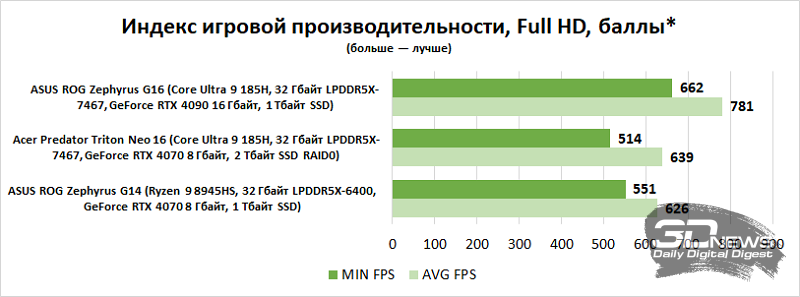
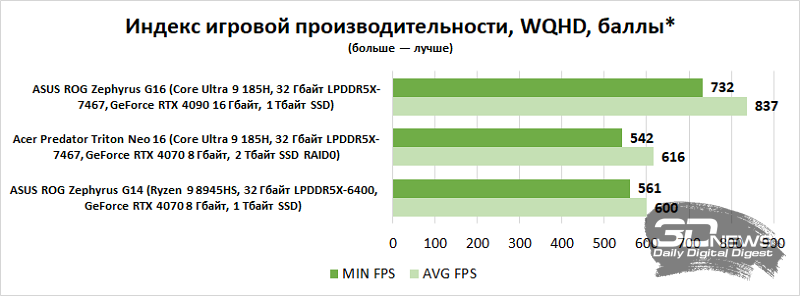
* Points are calculated as a percentage of the performance of the reference gaming system, multiplied by 10.
Previously, we found out that the video core in the GeForce RTX 4070 operates with a maximum power of 90 W. In another laptop with the same graphics, this parameter is 110 W. As a result, the average gaming performance of laptops does not differ much – closer to 2%, if we consider the average FPS. At the same time, in terms of the minimum frame rate, on the contrary, the ROG Zephyrus G14 is ahead – that is, the laptop provides a smoother picture in some games. We have repeatedly told and shown that the minimum FPS is influenced by many factors: from the platforms used and central processors with RAM to different versions of Windows builds and drivers.
For greater clarity, it was decided to test the ROG Zephyrus G14 not in the original resolution – the so-called 3K – but in a format close to WQHD. Testing shows that the mobile GeForce RTX 4070 provides an average of 60 frames per second at a resolution of 2560 × 1600 pixels in only four games out of 12. The way out of the situation is simple – you need to switch to a resolution of 1920 × 1200 pixels. In this format, the coveted 60+ FPS is already observed in eight games.
⇡#Resource-intensive applications
A fast gaming laptop is usually a fast workstation. Manufacturers of such laptops configure the operation of their products so that in resource-intensive projects the central processors go beyond generally accepted power limits. Essentially, we are dealing with factory overclocking of the CPU.
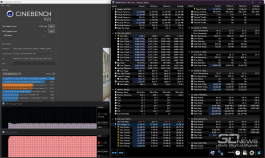
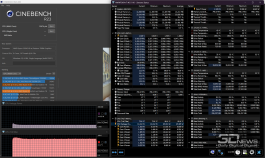
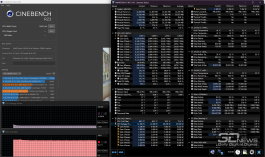
Test results
ROG Zephyrus G14 is very suitable for working with resource-intensive software. In Turbo mode, the power consumption of the 8-core Ryzen 9 8945HS reaches 80 W. As you can see, this turns out to be not enough to impose competition on Core Ultra 9 chips, which, so to speak, are superior in numbers (we are still comparing the performance of an 8-core AMD chip and a 16-core Intel “stone”). The difference in calculations cannot be called significant either: the ROG Zephyrus G16 is only 17% faster in Cinebench 2024.



⇡#Daily tasks
Gaming aside, most users don’t always need high performance from a laptop. The average person who spends time on a laptop surfs the web, watches videos and listens to music, communicates via instant messengers, conducts video conferences and sometimes uses office application packages. As a rule, to perform such tasks, high performance with 1-2 CPU cores, sufficient RAM and a fast storage are required. The following tests show how well gaming laptops handle everyday user tasks.


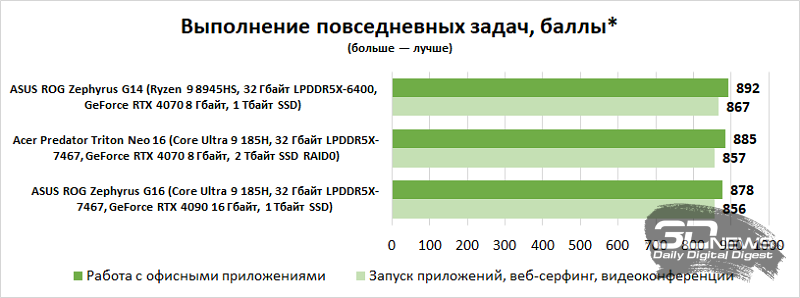

* Points are calculated as a percentage of the performance of the reference gaming system, multiplied by 10.
When performing everyday tasks, on the contrary, laptops with Intel chips play the role of catching up. The difference is symbolic, but it exists.
⇡#Offline work
All versions of the ROG Zephyrus G14 are equipped with a 73 Wh battery. In light operating modes, the laptop worked on a single battery charge for about 8-9 hours – a good result (above average) for gaming laptops, but far from a record. Testing was carried out in the “Quiet” + “Eco mode” mode – that is, the GeForce RTX 4070 graphics were disabled. Also, the display refresh rate has been reduced from 120 to 60 Hz, and the keyboard backlight and Slash Lighting have been turned off.
As already mentioned, the ROG Zephyrus G14 supports Power Delivery 3.0 technology, as well as a fast charging function: the laptop battery is charged from 0 to 50% in 30 minutes.
⇡#Conclusions
The tested model is unique of its kind. At the time of writing, other than the ROG Zephyrus G14, I did not find a computer for sale with a 14-inch matrix and a weight of up to 1.5 kg, equipped with a GeForce RTX 4070. Competitors offer models similar in format and functionality, but with a GeForce RTX 4060 on board – and with a slight difference in price.
The tested model has something to praise for. The build quality of the laptop was as expected. The installed OLED display is beautiful, no matter how you look at it – literally and figuratively. The functionality of the ROG Zephyrus G14 is also okay. The cooling system copes with its task and in most cases does it without strain. The battery charge is enough for half a day of work, but we can always take a second power supply or an external battery with us. Finally, Zephyrus received a comfortable keyboard and touchpad.
To be completely happy, the test model lacks the ability to install a second drive. I suppose this is not so easy to do from an engineering point of view. And the SSD itself in a laptop could be faster – it sounds more like a nitpick, but still.